This study presents a comprehensive seismic evaluation of steel frame structures with semi-rigid connections integrated with Chevron-Zipper bracing systems under near-fault earthquake excitations using OpenSees. The research aims to enhance the seismic resilience of such frames by mitigating lateral deformations and structural damage. Three archetypal models representing low-rise (5-story), mid-rise (8-story), and high-rise (12-story) buildings were developed, incorporating both pinned and semi-rigid (ductile) connections. A total of 84 structural configurations were subjected to dynamic nonlinear time history analyses using seven near-fault ground motion records. Comparative assessments were conducted for frames with and without zipper columns. Results indicate that the addition of zipper columns significantly improves seismic performance by reducing inter-story drifts and peak lateral displacements, particularly in frames with ductile connections. These findings underscore the effectiveness of the Chevron-Zipper bracing configuration in enhancing structural performance against near-fault seismic events.
Steel moment-resisting frame structures have long been favored in seismic design due to their strength, flexibility, and energy dissipation capacity. However, observations from past major earthquakes have highlighted significant vulnerabilities in traditional rigidly connected systems, particularly those using conventional bracing configurations [1, 2]. These systems often exhibit excessive inter-story drift, concentration of plastic hinges in undesired locations, and abrupt failure mechanisms, especially when subjected to the high intensity and impulsive nature of near-fault ground motions. Such performance issues underscore the need for improved structural configurations that can redistribute forces effectively and enhance ductility across the structure [3].
To address these limitations, innovative bracing strategies have emerged, with the Chevron bracing system being one of the most widely used due to its geometric simplicity and lateral load resistance. However, conventional Chevron bracing is known to induce unbalanced vertical forces in the event of brace buckling, leading to premature failure of beams and reduced overall ductility. An effective enhancement to this system involves the integration of a vertical zipper column connecting the beam intersections across multiple stories [4]. This zipper mechanism helps transfer unbalanced forces upward and facilitates a more uniform distribution of plasticity, thereby improving the frame’s deformation capacity and delaying structural collapse [5].
Parallel to these developments, the adoption of semi-rigid or ductile connections has been gaining prominence in seismic design. Unlike pinned or fully rigid connections, semi-rigid joints provide an optimal balance between strength and flexibility. They are capable of accommodating larger rotational demands and contributing to the energy dissipation of the frame while allowing for cost-effective and practical construction [6]. Their capacity to deform inelastically without immediate loss of load-carrying ability makes them particularly advantageous in seismic zones, where the ability to absorb and dissipate seismic energy is critical.
While individual studies have explored the benefits of zipper bracing systems and the advantages of semi-rigid connections, limited research has been conducted on the combined effect of these two mechanisms in multi-story steel frames, especially under near-fault seismic excitations [7]. Most existing investigations have focused on either pinned or rigid connection systems, neglecting the transitional behavior and potential benefits of semi-rigid frames. Moreover, the influence of structural height and connection type on the effectiveness of zipper columns remains insufficiently quantified.
This research addresses these gaps by systematically evaluating the seismic performance of steel moment-resisting frames with semi-rigid connections and Chevron-Zipper bracing systems. The study considers a set of representative 5-, 8-, and 12-story steel buildings to reflect low-, medium-, and high-rise structures [8]. Each structural model is analyzed using nonlinear dynamic time history methods in OpenSees, with seven near-fault ground motion records applied to simulate realistic seismic demands. Both pinned and semi-rigid connections are modeled to compare their influence on key performance indicators such as inter-story drift, peak lateral displacement, and plastic hinge development, with and without the inclusion of zipper columns.
The results of this investigation aim to provide a deeper understanding of how the integration of semi-rigid connections and vertical zipper columns affects the seismic response of steel structures across different building heights. Findings from this study are expected to contribute to the development of more resilient and cost-effective seismic design strategies, especially for regions exposed to near-fault seismic hazards. By combining advanced bracing configurations with connection flexibility, this approach has the potential to enhance structural safety, extend service life, and promote more reliable performance in critical infrastructure.
Enhancing the seismic performance of steel structures is critical to ensuring structural integrity during major earthquakes. A well-designed lateral force-resisting system must provide sufficient stiffness to control displacements, while also possessing enough ductility to dissipate energy through inelastic behavior [9]. One effective approach is the combination of Chevron bracing systems with vertical zipper columns and semi-rigid beam-to-column connections. This hybrid configuration offers both strength and energy dissipation capacity while reducing the possibility of abrupt failure mechanisms.
Chevron bracing, or the inverted-V bracing system, resists lateral forces primarily through axial actions in its diagonal members. Under seismic loading, one brace is subjected to tension while the other undergoes compression. As the compressive brace buckles, a vertical unbalanced force Vu is introduced at the intersection point of the braces with the beam. This force can be expressed as:
\[ \begin{equation} V_u = P_{b1} – P_{b2}, \end{equation}\tag{1}\]where Pb1 and Pb2 are the axial forces in the tension and compression braces, respectively. Upon buckling of the compression brace, Pb2 drops significantly, resulting in a large upward force on the beam that can lead to plastic hinge formation.
The inability of the Chevron system to redistribute these forces can cause excessive deformation at a single story level, often leading to soft-story behavior or beam failure. This behavior is particularly problematic in mid- to high-rise structures subjected to near-fault seismic excitations, which generate long-period velocity pulses.
To address the force redistribution limitations of Chevron bracing, a vertical zipper column is introduced to form the Zipper bracing system. The zipper column connects the brace-beam intersections of multiple stories and transfers the unbalanced vertical force Vu upward through the height of the structure. This allows the upper braces to sequentially yield and redistribute the lateral forces more uniformly.
The internal force equilibrium in a Zipper-braced frame can be represented as:
\[\begin{equation} \sum F_z = \sum V_u = \sum (P_{b1} – P_{b2}) = 0 \end{equation}\tag{2}\]indicating that the vertical forces induced by brace buckling are equilibrated through the zipper column, preventing excessive demands on any single beam. This configuration improves the post-buckling behavior, delays the formation of plastic hinges at critical locations, and enables a more ductile response.
Beam-to-column connections play a crucial role in defining the lateral response of moment-resisting frames. Connections can be idealized as pinned, semi-rigid, or fully rigid depending on their rotational stiffness Kθ. Semi-rigid connections allow partial moment transfer and are characterized by a nonlinear moment-rotation relationship:
\[\begin{equation} M = K_\theta \cdot \theta, \end{equation}\tag{3}\]where M is the moment transferred through the connection, and θ is the relative rotation between the beam and column. The stiffness ratio α is used to classify the connection as:
\[ \alpha = \frac{K_\theta}{K_r}, \]with Kr being the stiffness of a fully rigid connection. In this study, two types of connections are modeled: pinned (α = 0.1) and semi-rigid (α ≈ 0.4-0.6), based on standard classifications.
To ensure adequate ductility, the plastic rotation capacity θp of the connection must exceed a threshold value. It is typically derived from geometric and material properties:
\[ \begin{equation} \theta_p = \frac{M_p}{K_\theta}, \end{equation}\tag{4}\]where Mp is the plastic moment capacity of the beam. A connection is considered ductile if θp satisfies:
\[\begin{equation} \theta_p \geq \theta_{min}, \end{equation}\tag{5}\]where θmin is the minimum rotation required by design codes (e.g., 0.02-0.03 radians).
The integration of semi-rigid connections and Zipper bracing into steel frames provides multiple benefits under seismic loads:
The structural response under near-fault ground motions is significantly influenced by the flexibility and energy dissipation characteristics of both the bracing system and the connections. Semi-rigid connections permit controlled inelastic deformation and reduce the risk of brittle failure at the joints. The inclusion of zipper columns enables progressive engagement of bracing elements throughout the height, which helps distribute seismic demands more evenly.
In this research, the seismic performance of 5-, 8-, and 12-story frames is evaluated by incorporating Chevron-Zipper bracing and varying connection types. The nonlinear dynamic response under near-fault records is analyzed using OpenSees, with special focus on inter-story drifts, peak roof displacement, and hinge formation patterns. The goal is to quantify the benefits of the combined system in terms of ductility, stiffness, and stability for seismic design applications.
In order to evaluate the seismic performance of steel frames with semi-rigid and pinned connections combined with Chevron and Zipper bracing systems, three multi-story building frames were selected as representative models [11, 12]. The structures included 5-story (low-rise), 8-story (mid-rise), and 12-story (high-rise) configurations, reflecting typical building classifications in seismic regions. These models were initially designed using ETABS software, where the structural layout and member sizing were performed based on standard design procedures [13]. The member sections derived from the ETABS design were used for detailed seismic modeling and nonlinear dynamic analysis in OpenSees [14].
Each structure was modeled as a two-dimensional frame with three equal spans of 5 meters. All story heights were uniformly set at 3 meters. The Chevron bracing system was placed in the central span of each frame. Each model was evaluated in four configurations [15]:
This setup resulted in a total of 12 frame models (3 heights × 4 configurations). Each frame was subjected to seven different near-fault ground motion records, leading to 84 nonlinear time-history analyses in total.
The beams, columns, braces, and zipper columns were assigned steel sections according to the building height. Columns were modeled using square hollow sections (BOX type), beams used IPE profiles, and diagonal braces and zipper columns used circular hollow sections (CIRC type) [16]. The detailed distribution of cross-sections by story level is given in Table 1.
| Story Level | Beams (Braced Span) | Beams (Non-braced Span) | Columns | Braces / Zipper Columns |
|---|---|---|---|---|
| 1–3 | IPE400 | IPE300 | BOX350×350×20 | CIRC250-12 |
| 4–7 | IPE400 | IPE300 | BOX300×300×20 | CIRC200-12 |
| 8–10 | IPE300 | IPE270 | BOX250×250×15 | CIRC200-12 |
| 11–12 | IPE270 | IPE240 | BOX200×200×12 | CIRC150-10 |
In OpenSees, the steel material behavior was modeled using the Steel02 material, based on the Menegotto–Pinto model, which captures both kinematic and isotropic hardening effects. This model is suitable for cyclic loading and provides realistic stress-strain hysteresis for steel elements [17]. Beams, columns, and braces were defined using fiber-section elements (nonlinear forceBeamColumn elements), where the cross-sections were discretized into patches (squares and circles) representing steel fibers.
The bracing systems (Chevron and Zipper) were defined using truss elements for axial behavior. Connections were modeled using zeroLength elements at beam-to-column joints. These elements simulated the rotational spring behavior of semi-rigid and pinned connections [18]. Two types of multilinear uniaxial materials were defined for the connections:
The moment-rotation behavior of the semi-rigid connection was defined using:
\[\begin{equation} M(\theta) = \begin{cases} K_e \cdot \theta & \text{for } \theta \leq \theta_y \\ M_y + K_h \cdot (\theta – \theta_y) & \text{for } \theta > \theta_y \end{cases} \end{equation}\tag{6}\]where Ke is the initial elastic stiffness, Kh is the post-yield stiffness, My is the yield moment, and θy is the yield rotation.
Masses were defined based on the ETABS model and imported into OpenSees using the mass command at each node. Gravity loads were applied using the pattern Plain command. The total dead and live loads were converted to equivalent nodal forces. Seismic excitations were applied as acceleration time histories using the UniformExcitation command, with a Rayleigh damping ratio of 5% applied through the rayleigh command.
Seven near-fault ground motion records were selected based on intensity and velocity pulse characteristics. These records were scaled to match the design spectrum for each frame category [19]. Dynamic analyses were carried out using nonlinear time-history procedures with Newmark integration (β = 0.25, γ = 0.5). For each ground motion, frames were analyzed in all four bracing and connection configurations to assess performance differences [20].
Figures 1 and 2 show schematic representations of the 12-story frame modeled with Chevron and Zipper bracing systems, respectively. The central span contains the bracing elements, and the beam-column joints are assigned zero-length elements representing the pinned or semi-rigid connections.
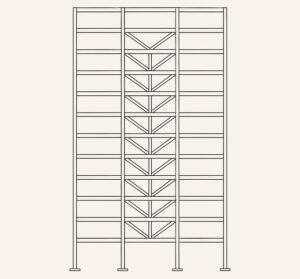
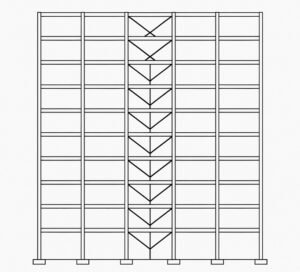
Accurate representation of seismic demand is essential for nonlinear time-history analysis, particularly when assessing structural performance under near-fault conditions [21]. Near-fault earthquakes often exhibit high-intensity ground motions with velocity pulses, forward directivity, and large spectral content, which significantly affect the dynamic behavior of structures [22]. In this study, seven real near-fault ground motion records were selected to evaluate the seismic response of low-, mid-, and high-rise steel frames with Chevron and Zipper bracing systems and varying connection rigidities [23].
The selected ground motions represent a diverse set of historical near-fault earthquakes with varying intensity levels, source-to-site distances, and frequency characteristics. These records were chosen based on their relevance, availability of metadata, and prior usage in benchmarking studies [24]. The chosen accelerograms include:
These ground motions were applied in both the longitudinal and transverse directions for 5-, 8-, and 12-story frames, resulting in a total of 84 time-history analyses (7 records × 4 frame configurations × 3 building heights).
Each record was characterized by peak ground acceleration (PGA), peak ground velocity (PGV), peak ground displacement (PGD), velocity-to-acceleration ratio (Vmax/Amax), and closest distance to the fault rupture (Rf). These parameters influence the dynamic demand imposed on the structures and are listed in Table 2.
| Record Name | PGA (g) | PGV (cm/s) | PGD (cm) | Vmax/Amax (s) | Distance (km) |
|---|---|---|---|---|---|
| El Centro – Imperial Valley | 0.348 | 35.2 | 3.6 | 0.101 | 6.1 |
| Kobe – KJMA | 0.821 | 87.9 | 18.2 | 0.107 | 0.9 |
| Kobe – Takarazuka | 0.695 | 62.3 | 13.5 | 0.090 | 1.2 |
| Northridge – Rinaldi | 0.846 | 92.4 | 11.2 | 0.109 | 5.4 |
| Kobe – Takatori | 0.617 | 75.1 | 16.3 | 0.122 | 1.5 |
| Parkfield – Fault Zone 1 | 0.338 | 41.6 | 6.1 | 0.123 | 3.5 |
| Chi-Chi – TCU065 | 0.569 | 70.7 | 14.8 | 0.124 | 2.3 |
To ensure a consistent basis for comparison and compliance with design standards, the ground motion records were scaled according to the guidelines of the Iranian Code of Practice for Seismic Resistant Design of Buildings (Standard No. 2800, 4th Edition) [25]. The scaling aimed to match the average spectral response of the selected records to the design spectrum over a specified period range, ensuring adequate representation of seismic demand across different structural periods.
The scaling factor Sf for each record was calculated as:
\[\begin{equation} S_f = \frac{S_{2800,{avg}}}{S_{{record,avg}}} \end{equation}\tag{7}\]where, S2800,avg is the mean spectral acceleration from the standard design spectrum (Standard 2800) and Srecord,avg is the mean spectral acceleration of the unscaled accelerogram.
The scaling was performed over the period range of 0.2T to 1.5T, where T is the fundamental period of the structure under analysis. Additionally, the scaled spectra were required to exceed 1.4 times the design spectrum over this range, ensuring a conservative and robust seismic demand.
Each scaled record was applied as a ground acceleration time history using the Uniform Excitation command in OpenSees, and the direction of excitation was chosen to align with the lateral bracing direction. A damping ratio of 5% was assumed for all dynamic analyses, implemented using Rayleigh damping.
The spectral properties of each accelerogram were analyzed and scaled using SeismoSignal software. After scaling, the ground motion files were exported and formatted for OpenSees input. The scaled acceleration records were then applied at the base of the structure, and all simulations were executed using direct integration with the Newmark method.
This section presents the analysis outcomes of nonlinear dynamic time-history simulations performed on 5-, 8-, and 12-story steel frames under seven near-fault ground motion records. The evaluation focused on the effectiveness of the zipper column in controlling key seismic response parameters such as relative story displacement and maximum roof displacement. Comparisons were made between four structural configurations: (1) pinned connections with Chevron bracing, (2) pinned connections with Zipper bracing, (3) semi-rigid connections with Chevron bracing, and (4) semi-rigid connections with Zipper bracing.
The relative story displacement (inter-story drift) is a critical measure of deformation demand and structural performance under seismic loading. The results showed a consistent reduction in relative displacements across all frames after the incorporation of the zipper column. For each building type, the reduction was evaluated for both pinned and semi-rigid connections under all seven ground motion records.
For the 5-story frame:
For the 8-story frame:
For the 12-story frame:
The observed reductions were dependent on the height of the building and the intensity and spectral characteristics of each ground motion. Figures 3, 4, and 5 illustrate the drift patterns for 12-, 8-, and 5-story models, respectively.
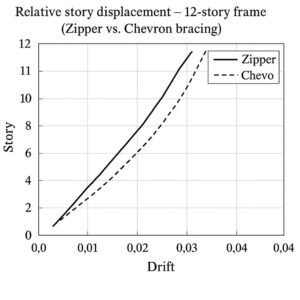
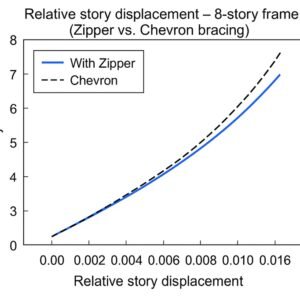
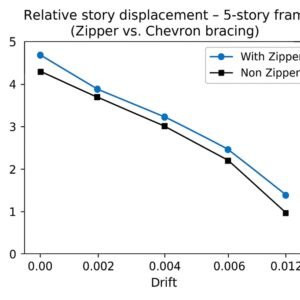
The reduction in relative displacements was most significant in the middle and lower stories, particularly up to the second or third level. This is attributed to the redistribution of unbalanced vertical forces through the zipper column, leading to a more uniform deformation profile and enhanced structural integrity.
In taller buildings, the zipper column demonstrated a more pronounced impact due to the accumulation of displacement demands over height. In contrast, the influence was less significant in low-rise buildings, particularly those with pinned connections. Medium-rise frames benefited substantially from the introduction of semi-rigid connections in combination with the zipper column.
The maximum displacement of the roof story provides an essential indicator of the global performance of the structure and the potential for overall instability or collapse. Table 3 summarizes the percentage reduction in roof displacement achieved by adding the zipper column for all frame types under different ground motion records.
| Record | 5-Story (Pinned) | 5-Story (Semi-Rigid) | 8-Story (Pinned) | 8-Story (Semi-Rigid) | 12-Story (Pinned) | 12-Story (Semi-Rigid) |
|---|---|---|---|---|---|---|
| Chi-Chi | 29 | 12 | 9 | 3 | 9 | 3 |
| El Centro | 6 | 4 | 6 | 8 | 8 | 2 |
| KJMA | 4 | 6 | 7 | 10 | 12 | 17 |
| Takatori | 6 | 7 | 9 | 12 | 15 | 18 |
| Rinaldi | 5 | 5 | 8 | 14 | 21 | 31 |
| Parkfield | 3 | 3 | 6 | 5 | 9 | 14 |
| Takarazuka | 6 | 5 | 10 | 8 | 11 | 19 |
The results clearly show that semi-rigid connections amplified the beneficial effect of the zipper column. The most significant reductions in roof displacement were observed in the 12-story semi-rigid frame, where the zipper column resulted in up to 31% reduction. In contrast, the improvements in the 5-story models were moderate due to the lower accumulation of seismic demand with height.
The vertical distribution of maximum story displacement was also analyzed, particularly for the 5-story semi-rigid frame under all records. Table 4 illustrates the percentage reduction in maximum displacement across all stories.
| Story Level | El Centro | Chi-Chi | Takarazuka | Parkfield | Average Reduction |
|---|---|---|---|---|---|
| 1st | 3 | 6 | 5 | 4 | 4.5 |
| 2nd | 5 | 9 | 7 | 5 | 6.5 |
| 3rd | 6 | 12 | 10 | 6 | 8.5 |
| 4th | 4 | 8 | 9 | 7 | 7.0 |
| 5th (Roof) | 4 | 12 | 8 | 3 | 6.75 |
The reduction was most significant in the middle stories, where displacement demand typically peaks. In low-rise buildings, the displacement profile showed relatively uniform improvement across all levels, contributing to a more integrated structural response.
The addition of the zipper column notably improved seismic performance in terms of drift and displacement reduction. Semi-rigid connections enhanced this effect due to their energy dissipation capabilities and rotational flexibility. High-rise buildings benefited the most, particularly in the control of inter-story drift concentration and peak roof displacement.
In low-rise frames, the benefit of the zipper column was less pronounced but still contributed to more uniform force distribution and integrated structural performance. Medium-rise frames showed substantial improvement when semi-rigid connections were adopted, suggesting that the interplay between connection flexibility and bracing configuration is a key factor in optimizing seismic response.
The findings validate the effectiveness of Chevron-Zipper bracing systems in enhancing performance metrics under severe near-fault excitations and highlight the importance of tailored connection modeling in the seismic design of steel structures.
This study presented a comprehensive investigation into the seismic performance of steel moment-resisting frames equipped with Chevron and Zipper bracing systems, considering both pinned and semi-rigid beam-to-column connections. The primary focus was to assess the influence of the vertical zipper column on the control of inter-story drift and maximum displacement under near-fault earthquake excitations, using detailed nonlinear dynamic time-history analyses conducted in OpenSees.
Three representative building configurations–5-, 8-, and 12-story frames–were designed and analyzed under seven selected near-fault ground motion records. These structures were modeled in four bracing-connection configurations: (1) pinned-Chevron, (2) pinned-Zipper, (3) semi-rigid-Chevron, and (4) semi-rigid-Zipper systems. The results from 84 dynamic simulations were systematically compared to quantify the benefits of zipper bracing and connection flexibility.
The findings from the analyses revealed several key conclusions:
The results of this study demonstrate that combining Zipper bracing systems with semi-rigid connections offers a practical and effective strategy for enhancing the seismic resilience of steel frames, particularly in high-risk near-fault regions. This hybrid approach leverages the benefits of both improved force redistribution through the zipper column and the enhanced ductility provided by semi-rigid joints.